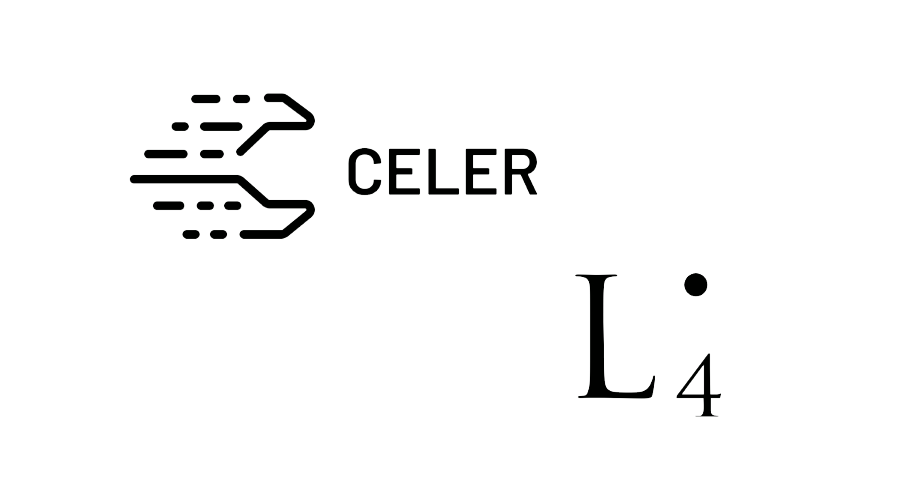Celer, an off-chain protocol for scaling blockchains and L4 Ventures, a Web 3 developer have announced that they will partner on the development of open-source state channels technology.
After several months of informal collaboration, the teams plan to work further together in order to learn from each others contrasting design decisions in their separate codebases, develop shared standards for encoding off-chain state, and connect generalized state channels into networks, developer interfaces, to collaborate on cutting-edge research, including zero-knowledge state channel designs, formal verification of generalized state channel models, and more.
L4 is helping build Counterfactual, an open-source framework for generalized state channels on Ethereum. Counterfactual’s goal is to make it easy for developers to build distributed applications using state channels, leading to immediate improvements in usability, speed, and cost. On August 1st, L4 released the smart-contracts layer of Counterfactual. Earlier this summer, L4 published a detailed technical paper designed to serve as an essential reference for the Ethereum developer community.
Celer has been building the Celer Network, an integrated off-chain technology, and crypto economy stack to bring scalability to blockchain applications. Earlier this summer, Celer Network published their white paper documenting their layered technology stack including cChannel, a generalized state channel specification; cRoute, a provably optimal state routing algorithm; cOS, an off-chain blockchain VM architecture, developer framework and user runtime. On June 25th, Celer released their cChannel-eth smart-contracts repository, an implementation of the cChannel abstraction on the Ethereum blockchain that can be used along with cOS to create state channel applications (see MVP demo).
cChannel-eth and the Counterfactual smart contracts were independently developed by Celer and L4. The differences between the teams’ designs saw Celer Network choose to focus on a set of full-featured on-chain components with out-of-box features and structured off-chain object schemas, while L4 adopted a minimalist on-chain presence to allow best future-proof upgradability.
The Celer team said:
“Ultimately, every state channel team shares the same goals. We’re not competing against each other, we’re aiming to move as many blockchain operations off-chain as possible and to progress the state of the art in dapp design. We’re competing with blockchains that sacrifice too much decentralization in exchange for short-term performance benefits. We’re competing with the old web, and with a centralized financial system.”
“Since we were first introduced to each other by Joseph Poon earlier this year, Celer and L4 have been frequently exchanging ideas, discussing mutual technical challenges, and beginning an in-depth collaboration on a shared vision for how state channels can function at scale. As we have come to know each other better and gained a high respect for each other’s technical contributions to state channels technology, we’ve come to believe that the best path forward is to collaborate more closely.”
“Our smart-contract repositories will remain separate for the immediate future, but we will be working closely together to ensure that Counterfactual and cChannel are compatible standards.”
Below are more details on the immediate work the teams will look to collaborate on:
Shared standards
In order for state channels to succeed at scale, widely adopted standards are needed. Collaborating closely will increase the speed at which blockchain applications can scale and reach mass adoption. The Celer team says it is excited to work on standards and interfaces that maintain these shared values:
- Maximizing privacy in state channel designs through solutions like minimal on-chain footprints and zero knowledge dispute resolution proofs.
- Minimizing on-chain state bloat through contract design that uses smart selections of cryptographic data structures.
- Providing expertly optimized, formally verified, and highly audited components that developers of decentralized applications can rely upon without repeatedly re-inventing the wheel.
- Support for multiple parallel operations inside of a single channel that does not interfere with each other.
- Finding the right balance between full-featured on-chain smart contracts with simple off-chain interaction and minimal on-chain presence with full upgradability.
- Finally, to establish clear standards for how all of these generalized state channels will fit together into a global, multi-blockchain network where any user can easily connect to any other.
Learning from differences in designs
With the different design choices, Celer primarily sees this as a learning opportunity — both for themselves and for the ecosystem — to better understand the tradeoffs within the larger design space of state channels.
The Celer team remarked:
“One of the most jarring differences in our designs has been the encoding of off-chain state. In cChannel-eth, Celer has aimed for maximum portability of the data structure through the use of Google’s protobufs, a generic data exchange format. Counterfactual, with an aim for developer simplicity and compatibility with existing Ethereum libraries, encodes all data using Ethereum’s native RLP encoding in a way that is compatible with the experimental ABIEncoderV2 that has been included in the Solidity language since Solidity 0.4.17. We agree there are clear paths to take to work towards a unified standard that can maximize both data portability and developer tool compatibility.”
Collaborative research on new tech
With Celer and L4 both sharing an interest in pushing forward state channels tech, it was noted some areas being discussed for collaboration in the future:
- Zero knowledge state channel applications.
- Using ZK proofs in dispute cases.
- Using hashladders instead of HL registries to minimize dispute costs.
- Formal verification of generalized state channel models.
- Optimizing the on-chain contract layer while preserving some “out of the box” features.
- Joint research publications to increase the ecosystem’s understanding of layer 2 technologies.
